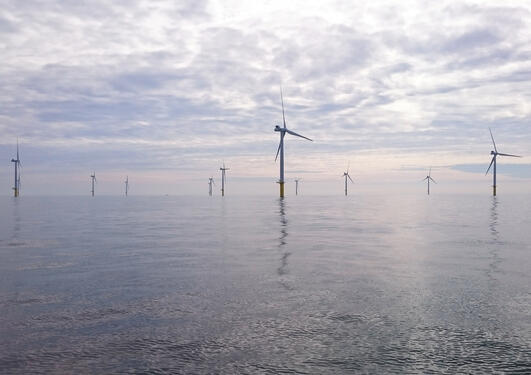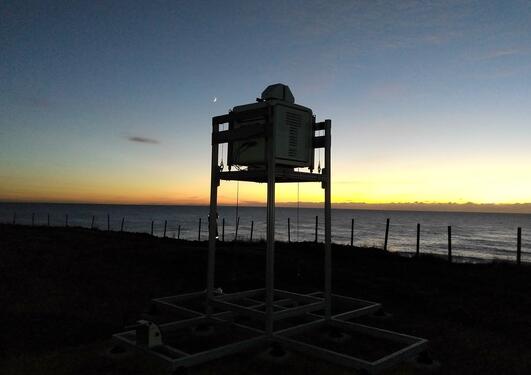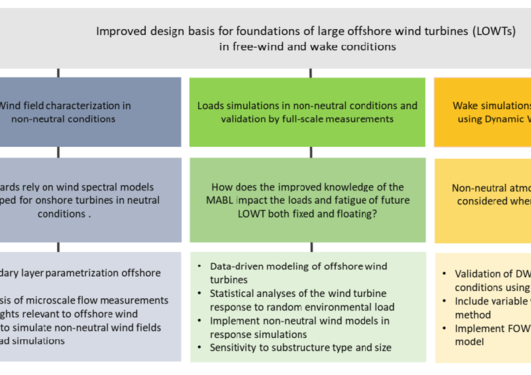- E-mailetienne.cheynet@uib.no
- Visitor AddressAllégaten 55, 4th floor5007 BergenRoom485
- Postal AddressPostboks 78035020 Bergen
Boundary layer meteorology:
- Characterization of the coherence of turbulence above the sea and in Norwegian fjords.
- Influence of the topography on the mean and turbulent flow characteristics.
- Synthetic turbulence generation in the atmospheric surface layer.
- Influence of the blocking by the surface on the spectral characteristics of turbulence.
Wind engineering:
- Turbulent wind load modelling on long-span bridges.
- Data-driven modelling for structural dynamics.
- Full-scale vibration analysis.
Lidar remote sensing of wind:
- Can scanning Doppler wind lidars measure turbulence?.
- Study of the flow around bridges with short-range and long-range wind lidar instruments.
Courses
- SDG310: Introduction: Interdisciplinary Approaches to Sustainable Development (2022-present)
- ENERGI322 Offshore wind energy - part 2 (2022-present)
- ENERGI321 Offshore wind energy - part 1 (2023-present)
- ENERGI210 Wind turbine aerodynamics (2022-2023)
- ENERGI230 Miljø og energi (2023-present)
- ENERGI101: Introduksjon til energikjelder og forbruk (2020)
Main supervision of PhD students:
- Yuanchen Wan (UiB): Wind-induced loading on solar collector arrays (2024-)
Co-supervision of PhD students:
- Nicolò Daniotti (UiS): Analysis of the turbulent wind loading on a long-span bridge in full-scale (2017-2022)
Mauro Ghirardelli (GFI/UiB): Development and test of a drone-based sonic anemometer system (2021-2024)
Rieska Putri (UiS): The impact of refined met-ocean conditions on floating wind turbiner responses (2017-2023)
Main supervision of Master students:
- Paulius Kavaliauskas (UiB): Can a dual pulsed lidar system measure the lateral coherence of turbulence? (2023)
Co-supervision of Master students:
- Julie-Ann Knight (UiS): The Influence of Different Unstable Turbulent Wind Spectra on the Motions and Loads on a Floating Wind Turbine (2019)
- (2024). Metocean conditions at two Norwegian sites for development of offshore wind farms. Renewable Energy. 1-17.
- (2024). Gone with the wind? Wind farm-induced wakes and regulatory gaps. Marine Policy. 12 pages.
- (2024). Experimental Characterization of Propeller-Induced Flow (PIF) below a Multi-Rotor UAV. Atmosphere.
- (2023). Wind turbines and wind farm characteristics.
- (2023). Gone with the wind? Wind farm-induced wakes and regulatory gaps.
- (2023). Flow Structure around a Multicopter Drone: A Computational Fluid Dynamics Analysis for Sensor Placement Considerations. Drones. 22 pages.
- (2022). Unfrozen skewed turbulence for wind loading on structures. Applied Sciences. 1-22.
- (2022). Turbulence in a coastal environment: the case of Vindeby. Wind Energy Science. 1693-1710.
- (2022). Offshore Wind Ressources.
- (2022). Metocean Conditions at Two Norwegian Sites for Development of Offshore Wind Farms.
- (2022). A one-year comparison of new wind atlases over the North Sea. Journal of Physics: Conference Series (JPCS). 1-11.
- (2021). The COTUR project: Remote sensing of offshore turbulence for wind energy application. Atmospheric Measurement Techniques. 6137-6157.
- (2021). Structural monitoring of OWTs for predictive maintenance .
- (2021). SUMO and SAMURAI – GFI/UiB drones for wind energy reserach.
- (2021). Potential and challenges of wind measurements using met-masts in complex topography for bridge design: Part II – Spectral flow characteristics. Journal of Wind Engineering and Industrial Aerodynamics.
- (2021). Potential and challenges of wind measurements using met-masts in complex topography for bridge design: Part I - Integral flow characteristics. Journal of Wind Engineering and Industrial Aerodynamics. 20 pages.
- (2021). Observations of bridge stay cable vibrations in dry and wet conditions: A case study. Journal of Sound and Vibration. 1-16.
- (2021). Full-scale observations of bridge stay cable vibrations in a wet state. 7 pages.
- (2021). Dual lidar wind measurements along an upstream horizontal line perpendicular to a suspension bridge. IOP Conference Series: Materials Science and Engineering. 11 pages.
- (2021). Aerodynamic study of a suspension bridge deck by CFD simulations, wind tunnel tests and full-scale observations. IOP Conference Series: Materials Science and Engineering. 12 pages.
- (2020). The influence of terrain on the mean wind flow characteristics in a fjord. Journal of Wind Engineering and Industrial Aerodynamics. 1-15.
- (2020). Improved long-span bridge modeling using data-driven identification of vehicle-induced vibrations. Structural Control and Health Monitoring. 18 pages.
- (2019). The COTUR campaign - measuring offshore turbulence and coherence with lidars.
- (2019). The COTUR campaign - measuring offshore turbulence and coherence With lidars.
- (2019). Influence of the Measurement Height on the Vertical Coherence of Natural Wind. Lecture Notes in Civil Engineering. 207-221.
- (2019). Identifying Traffic-Induced Vibrations of a Suspension Bridge: A Modelling Approach Based on Full-Scale Data. Conference Proceedings of the Society for Experimental Mechanics Series. 93-101.
- (2019). Flow distortion recorded by sonic anemometers on a long-span bridge: Towards a better modelling of the dynamic wind load in full-scale. Journal of Sound and Vibration. 214-230.
- (2019). Flow Distortion Recorded by Sonic Anemometers on a Long-Span Bridge. Lecture Notes in Civil Engineering. 192-206.
- (2019). COTUR - Estimating coherence and turbulence with LIDARs.
- (2018). Velocity spectra and coherence estimates in the marine atmospheric boundary layer. Boundary-Layer Meteorology. 1-32.
- (2018). Operational modal analysis with automated SSI-COV algorithm.
- (2018). Coupled aerodynamic and hydrodynamic response of a long span bridge suspended from floating towers. Journal of Wind Engineering and Industrial Aerodynamics. 19-31.
- (2018). Complementary use of wind lidars and land-based met-masts for wind measurements in a wide fjord . Journal of Physics: Conference Series (JPCS). 12 pages.
- (2018). Complementary use of wind lidars and land-based met-masts for wind characterization in a wide fjord.
- (2018). COTUR Measuring coherence and turbulence with lidars.
- (2017). Time-Domain Analysis of Wind-Induced Response of a Suspension Bridge in Comparison With the Full-Scale Measurements. 12 pages.
- (2017). Temperature effects on the modal properties of a suspension bridge. Conference Proceedings of the Society for Experimental Mechanics Series. 87-93.
- (2017). Spectral characteristics of surface-layer turbulence in the North Sea. Energy Procedia. 414-427.
- (2017). Measurements of Surface-Layer Turbulence in a Wide Norwegian Fjord Using Synchronized Long-Range Doppler Wind Lidars. Remote Sensing. 26 pages.
- (2017). Full-scale observation of the flow downstream of a suspension bridge deck. Journal of Wind Engineering and Industrial Aerodynamics. 261-272.
- (2017). Full-scale monitoring of wind and suspension bridge response. IOP Conference Series: Materials Science and Engineering. 14 pages.
- (2017). Damping estimation of large wind-sensitive structures. Procedia Engineering. 2047-2053.
- (2017). Assessing the potential of a commercial pulsed lidar for wind characterisation at a bridge site. Journal of Wind Engineering and Industrial Aerodynamics. 17-26.
- (2016). Wind-induced vibrations of a suspension bridge: A case study in full-scale.
- (2016). Wind-induced vibrations monitoring with satellite navigation.
- (2016). Wind Coherence Measurement by a Single Pulsed Doppler Wind Lidar. Energy Procedia. 462-477.
- (2016). Earthquake simulation and fitting.
- (2016). Buffeting response of a suspension bridge in complex terrain. Engineering structures. 474-487.
- (2016). Application of short-range dual-Doppler lidars to evaluate the coherence of turbulence. Experiments in Fluids. 17 pages.
- (2015). Buffeting response of a bridge at the inlet of a fjord. . In:
- (2015). Proceedings of the 14th International Conference on Wind Engineering, 2015, Porto Alegre, Brasil. International Conference on Wind Engineering.
- (2015). Assessment of wind conditions at a fjord inlet by complementary use of sonic anemometers and lidars. Energy Procedia. 411-421.
- (2015). Application of lidars for assessment of wind conditions on a bridge site . . In:
- (2015). Proceedings of the 14th International Conference on Wind Engineering, 2015, Porto Alegre, Brasil. International Conference on Wind Engineering.
- (2014). Wind-induced response of a bridge at the inlet of a fjord.
- (2014). Wind characteristics on a suspension bridge at the inlet of a fjord.
More information in national current research information system (CRIStin)
Education
2013–2016: PhD, University of Stavanger (UiS), Stavanger, Norway.
2009–2012: MSc, École Nationale Supérieure de Mécanique et d’Aérotechnique (ISAE-ENSMA), Futuroscope technopole, France
Employment record
2019-present: Post-doctoral researcher, University of Bergen, Bergen, Norway.
2016-2019: Post-doctoral researcher, University of Stavanger, Stavanger, Norway.
2013-2016: PhD student, University of Stavanger, Stavanger, Norway
BEL-FLOAT (2023-2026): The BEL-Float project focuses on developing Belgium's expertise in floating wind technology through academic innovation. The project aims to prepare new researchers with the necessary skills for floating wind energy and to strengthen the Belgian-Norwegian partnership in offshore wind.
ImpactWind SouthWest (2022-2027): ImpactWind SouthWest is a project led by NORCE, aiming to transform offshore wind development through collaboration, an open database, a research program, and educational initiatives. It aims to make the licensing process for Norwegian offshore wind faster, contributing to sustainable energy and job creation in Norway
LOWT (2021-2025): Large Offshore Wind Turbines (LOWT):structural design accounting for non-neutral wind conditions
This project will develop new knowledge and models to improve the design basis for large floating wind turbines (LOWT)(>12MW) in freewind and wake conditions. Observations from Hywind Scotland have shown the thermal stratification of the atmosphere can substantially affect the structural response of a wind turbine to the incoming turbulent flow. The first objective is to use wind data from several offshore sites to characterise the wind field in non-neutral atmospheric conditions. The project will use high-frequency wind data combined with a brand new remote sensing dataset (COTUR). In the COTUR campaign the incoming flow over the ocean was recorded, both within and above the surface layer, thus providing new insight on the applicability surface-layer scaling to model the turbulent wind loads on LOWT. This unique dataset will be analysed for the first time to the to indicate whether the turbulence models used in the standards, which mainly relies on surface-layer scaling, are appropriate or not. The final output will be to recommend suitable wind and coherence model for in non-neutral conditions as input to free wind aeroelastic simulations and DWM models offshore. The second objective is to validate the simulated wind turbine response using full scale data from offshore wind farms (Alpha Ventus, Sheringham Shoal, and Zefyros/Hywind Demo). The validated simulation tools will then be used to quantify the effect of non-neutral atmospheric conditions on future LOWT (>12MW) to ensure safe and cost-effective design in the next generation of offshore wind farms in Norway and beyond. The final focus of the project is wake simulations of LOWT in non-neutral conditions using DWM model. High-fidelity CFD simulations will be used to include variable velocity shear in the DWM method and validate the wake meandering in non-neutral conditions. The non-neutral wind spectra and coherence from the data analysis work will be used as input for the DWM simulations.
COTUR (2018-2020): Measuring coherence and turbulence with lidars (COTUR)
The size of offshore wind turbines has increased significantly since the installation of the world’s first commercial offshore wind turbine at Vindeby in 1991. The average offshore wind turbine capacity has increased from 500 kW in the 1990s to 3 MW by the end of 2010. Today, the largest offshore wind turbines have a rated power of 9 MW and a rotor diameter of 164 meters. Large, floating wind turbines pose new challenges compared to bottom-fixed turbines. In particular, the Hywind Scotland wind farm posed new challenges with respect to turbulence and coherence. There is a need for a better understanding of the horizontal coherence over large rotors offshore, but few measurements are available for such analyses. The main objective of the project is to improve the understanding of offshore wind coherence through measurements with lidars. The measurements will form a new, unique and highly relevant dataset for future offshore wind research. The collected data and corresponding meta-data will be stored in a database for later analysis.



